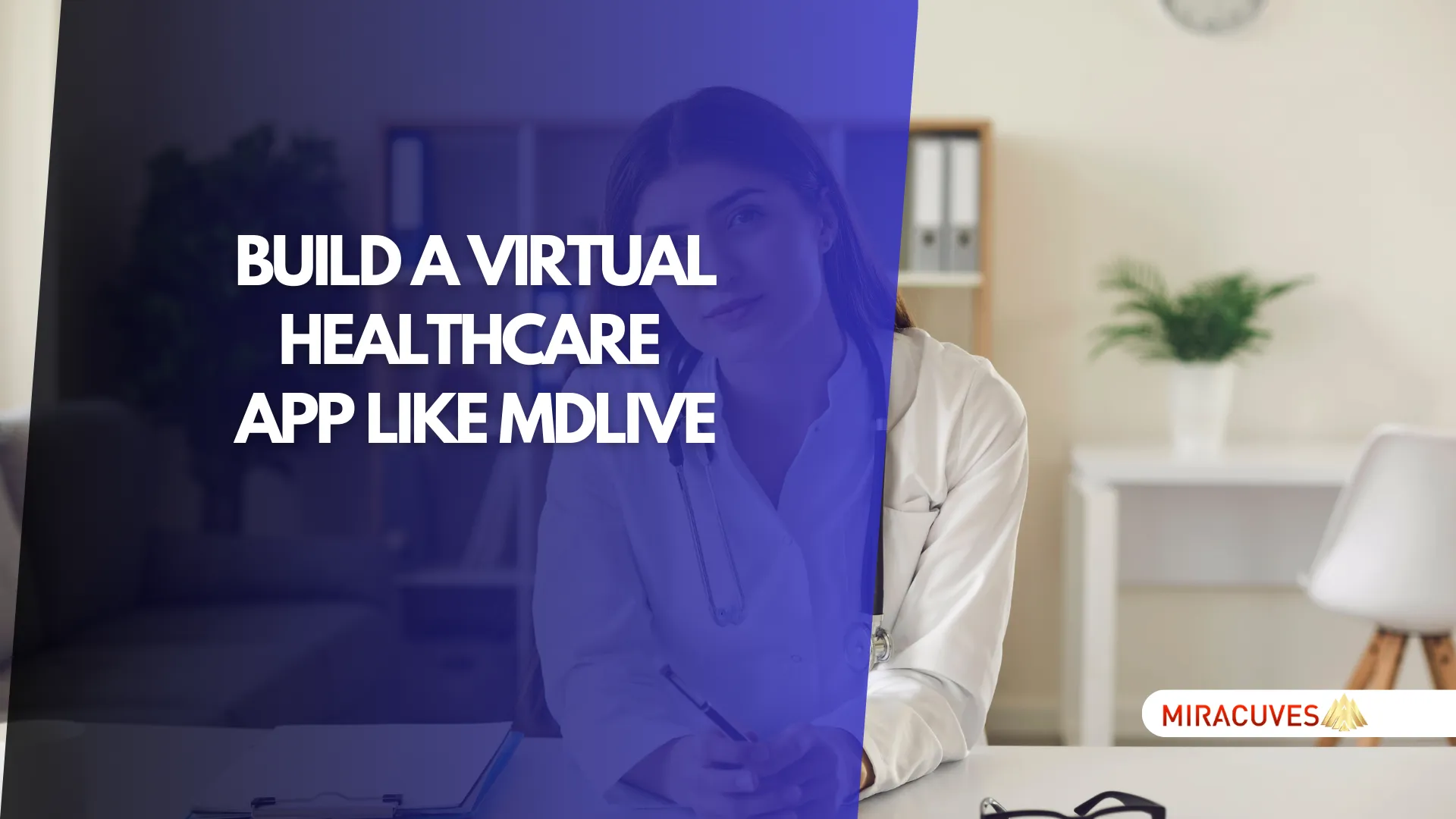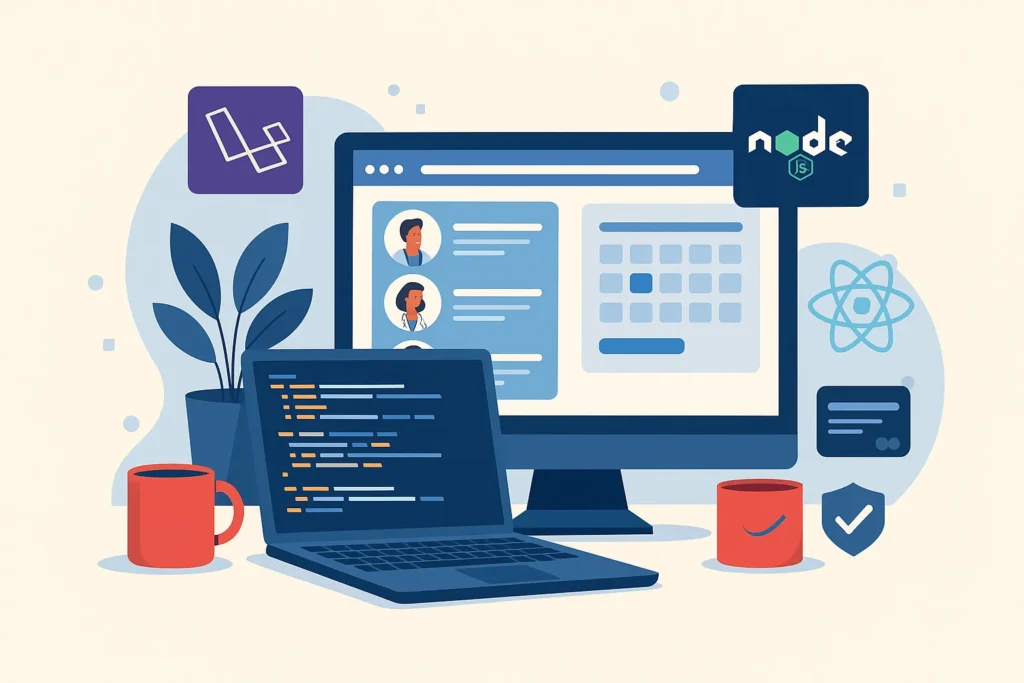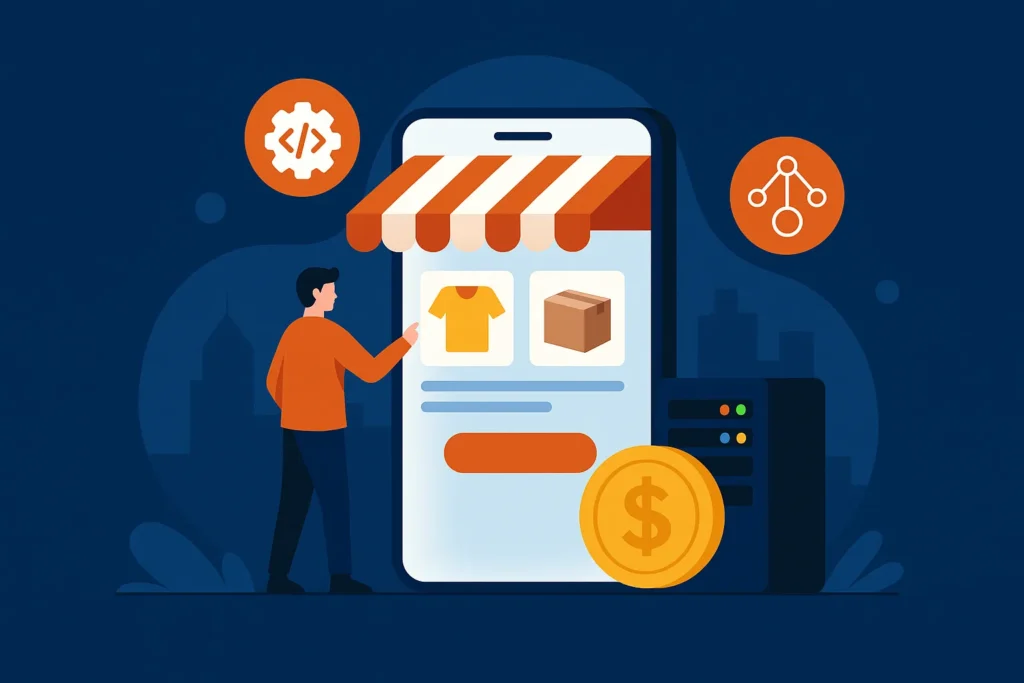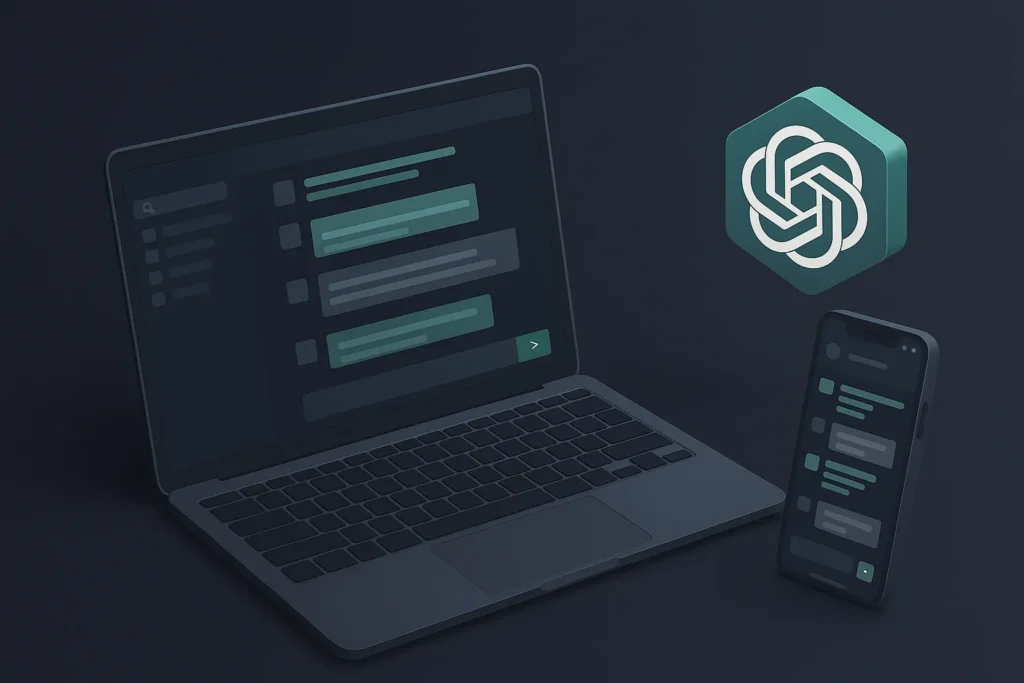In today’s digital era, the healthcare industry is rapidly transforming, and telemedicine is at the forefront of this revolution. One app leading the charge in virtual healthcare is MDLive, which connects patients to doctors, therapists, and specialists through video, phone, or chat consultations. As the demand for virtual healthcare grows, especially in the wake of the pandemic, building an app like MDLive offers a lucrative opportunity for businesses to enter the telemedicine space.
However, developing a full-fledged telemedicine app from scratch can be time-consuming and expensive. This is where Miracuves Solutions comes in, providing ready-made app solutions that are not only cost-effective but also drastically reduce the development timeframe. In this blog, we’ll explore the entire development process of building an MDLive-like app, and how Miracuves Solutions can help you launch your app in just 10 days at 10% of the global cost.
What is MDLive and What Does It Do?
MDLive is a popular telemedicine platform that allows patients to access healthcare services anytime, anywhere. With MDLive, users can connect with board-certified doctors, therapists, and specialists for virtual consultations through secure video, phone, or chat. This app covers a wide range of healthcare services, including urgent care, mental health, dermatology, and more. By offering remote care, MDLive eliminates the need for in-person visits, providing patients with quick, reliable, and affordable access to healthcare professionals from the comfort of their own homes.
MDLive’s key features include appointment scheduling, video consultations, electronic prescriptions (e-prescriptions), and secure patient-doctor messaging. These features are not only convenient but also essential for providing a seamless healthcare experience in the digital age. The app has become an industry leader in telemedicine, with millions of users relying on its services to get timely medical advice, prescriptions, and follow-up care.
The growing demand for virtual healthcare services, especially in the post-pandemic world, makes building an app like MDLive a highly attractive option for businesses. By entering this space, you can cater to the evolving needs of patients seeking fast, remote access to healthcare professionals.
Why Build This App?
Telemedicine has witnessed explosive growth in recent years, driven by the global shift toward digital health solutions. With the COVID-19 pandemic accelerating the need for remote healthcare, platforms like MDLive have become indispensable. Building a virtual healthcare app like MDLive allows businesses to tap into this rapidly growing market and meet the demands of modern patients who value convenience, accessibility, and affordability in healthcare.
Developing an app like MDLive is not only a smart business move but also a way to provide a valuable service that can make healthcare more inclusive and accessible to all. From individuals in rural areas with limited access to doctors, to those who prefer the comfort of their homes, telemedicine apps are bridging gaps in healthcare delivery. By offering a platform that connects patients with healthcare professionals in real time, you’re not just building an app—you’re creating a solution that meets the healthcare needs of today’s fast-paced, digital world.
The best part? Miracuves Solutions can help you build this app at just 10% of the global cost. For instance, if the global development cost for a telemedicine app is around $6000, Miracuves Solutions delivers the same ready-made solution for just $600. Not only that, but while the global development timeframe might take up to 1 month, Miracuves Solutions can get your app ready in as little as 10 days—allowing you to enter the market faster and start serving patients sooner.
Read More “How to Build an App Like Doctor on Demand: Features, Cost, and Development Process“
How to Differentiate Your App from Others
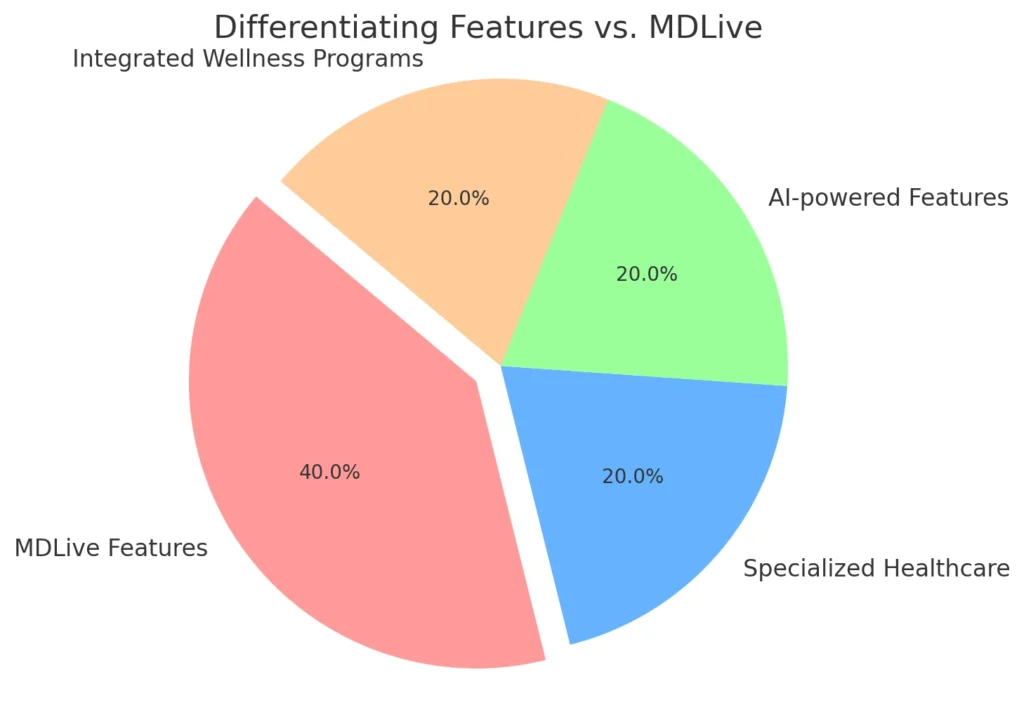
In the crowded telemedicine market, simply replicating the features of MDLive won’t be enough to stand out. To truly make an impact and attract users, you need to offer something unique—whether that’s enhanced functionality, a more personalized user experience, or additional services that cater to specific needs.
One way to differentiate your app is by focusing on specialized healthcare services. While MDLive covers a wide range of general healthcare needs, you could target specific fields such as mental health, pediatric care, or chronic disease management. By catering to niche audiences, you can attract users who are looking for specialized support that general telemedicine apps may not provide.
Another potential differentiator is incorporating AI-powered features like symptom checkers or virtual health assistants that can guide patients before they consult with a doctor. These tools not only improve the user experience but also streamline the workflow for healthcare providers by handling initial patient queries.
Additionally, adding features like integrated wellness programs—such as fitness tracking, medication reminders, or mental health resources—can offer users a more holistic approach to their healthcare. By blending telemedicine with preventive care, your app could become a go-to solution for users who want to manage their overall well-being, not just their medical appointments.
Market Size, Growth, Revenue, and Business Model
| Region | Market Size (2021) | Projected Market Size (2027) | Annual Growth Rate (CAGR) |
|---|---|---|---|
| North America | $55 billion | $130 billion | 15.5% |
| Europe | $35 billion | $95 billion | 17.2% |
| Asia-Pacific | $20 billion | $85 billion | 19.1% |
| Latin America | $12 billion | $35 billion | 16.8% |
| Middle East & Africa | $8 billion | $21 billion | 14.3% |
The telemedicine industry has seen exponential growth, with a projected global market size expected to reach over $396 billion by 2027. This rapid expansion is driven by several factors, including the convenience of virtual healthcare, advancements in technology, and an increased focus on patient-centered care. As more individuals become accustomed to digital solutions in healthcare, the demand for telemedicine services continues to rise.
For businesses looking to build an app like MDLive, the revenue potential is significant. The telehealth market offers a variety of monetization models, from subscription-based services to pay-per-visit consultations and corporate partnerships where companies offer telemedicine as part of their employee healthcare benefits. Additionally, revenue can be generated through in-app purchases, premium memberships, and add-on services such as wellness programs or mental health support.
With telemedicine becoming an integral part of healthcare systems worldwide, the opportunity to develop a scalable, profitable app in this sector has never been greater. By creating a robust and user-friendly app, businesses can tap into this thriving market and establish a steady stream of revenue.
The telemedicine industry is projected to reach over $396 billion by 2027, indicating significant potential for businesses entering this space, as outlined in various telemedicine market growth reports.
Features of an MDLive-Like App
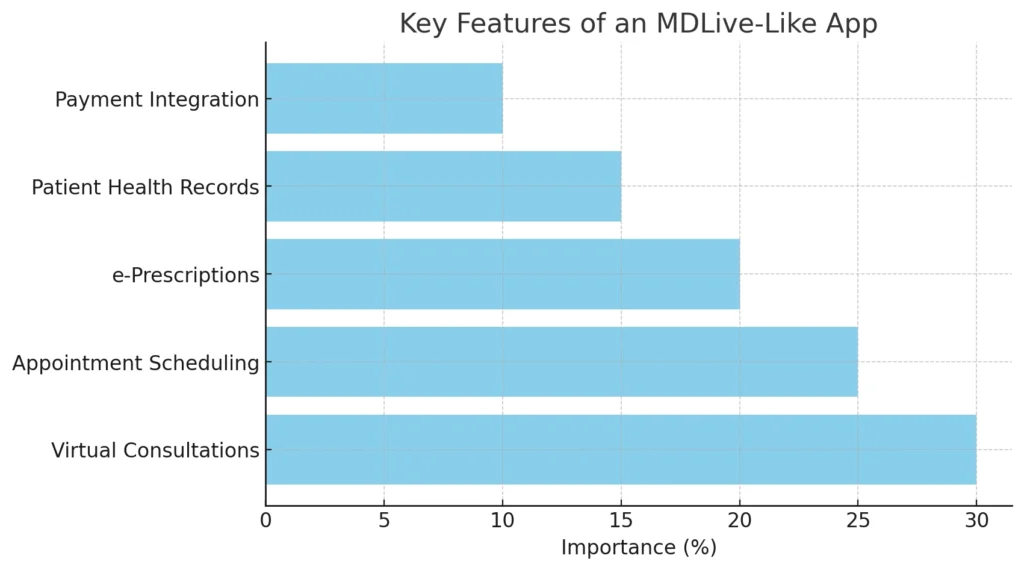
Building an app like MDLive requires integrating several key features to provide a seamless and efficient virtual healthcare experience for both patients and healthcare providers. These features are crucial for ensuring the app’s usability, functionality, and overall success in the telemedicine market.
- Virtual Consultations: The cornerstone of any telemedicine app, virtual consultations allow patients to connect with doctors via video, voice, or chat. This feature must be reliable, secure, and easy to use.
- Appointment Scheduling: Patients should be able to easily schedule appointments with healthcare providers based on availability. Integrating real-time scheduling ensures that both patients and doctors can manage their time efficiently.
- Electronic Prescriptions (e-Prescriptions): Allowing doctors to send prescriptions directly through the app simplifies the process for both patients and pharmacies. This feature ensures that patients can quickly receive the medications they need without unnecessary delays.
- Patient Health Records: The app should provide a secure platform for patients to store and manage their health records. These records should be accessible to both patients and doctors during consultations.
- Payment Integration: Secure and convenient payment options should be integrated into the app, allowing users to pay for consultations directly within the platform.
In addition to these core features, consider launching your app with a Minimum Viable Product (MVP) approach. An MVP allows you to release a version of the app with just the essential features, gather feedback, and make improvements before rolling out additional features. This approach saves time and resources, helping you enter the market quickly.
Technical Requirements
| Component | Description | Technologies |
|---|---|---|
| Frontend Development | User interface for mobile and web applications, ensuring responsiveness and usability. | React Native, Flutter |
| Backend Development | Server-side logic to handle requests, data processing, and database interactions. | Node.js, Ruby on Rails |
| Database Management | Storage and management of patient data, appointment schedules, and records. | MongoDB (NoSQL), PostgreSQL (Relational) |
| Security Protocols | Measures to protect sensitive healthcare data, ensuring compliance with regulations. | SSL/TLS encryption, HIPAA compliance |
| API Integrations | Third-party services that enhance app functionality (e.g., payments, video calls). | Stripe, PayPal, Zoom, WebRTC |
| Cloud Infrastructure | Scalable solutions for hosting the app and managing resources effectively. | Amazon Web Services (AWS), Google Cloud Platform (GCP) |
Building a telemedicine app like MDLive involves several technical components that ensure the platform is robust, secure, and user-friendly. Understanding these requirements is crucial for a successful development process.
- Technology Stack:
- Frontend Development: The user interface (UI) of the app should be intuitive and responsive. Common technologies for front-end development include React Native or Flutter for cross-platform mobile apps, which allow for seamless performance on both iOS and Android devices.
- Backend Development: The backend infrastructure manages data and user requests. A reliable server-side language such as Node.js or Ruby on Rails can be used, along with frameworks that handle API requests effectively.
- Database Management:
- A secure and scalable database is essential for storing patient data, appointment schedules, and medical records. Popular choices include MongoDB for NoSQL databases or PostgreSQL for relational databases, both of which provide high performance and flexibility.
- Security Protocols:
- Given the sensitive nature of healthcare data, implementing strong security measures is paramount. This includes using encryption protocols (such as SSL/TLS) for data transmission, ensuring compliance with regulations like HIPAA, and implementing authentication mechanisms like two-factor authentication (2FA).
- API Integrations:
- Integrating third-party APIs can enhance your app’s functionality. This may include payment gateways (like Stripe or PayPal), video conferencing tools (like Zoom or WebRTC), and analytics tools to track user engagement and improve the app over time.
- Cloud Infrastructure:
- Leveraging cloud services like Amazon Web Services (AWS) or Google Cloud Platform (GCP) ensures scalability and reliability. These platforms provide the necessary resources to handle varying loads and offer additional services such as storage, database management, and server hosting.
By carefully selecting the right technology stack and ensuring robust security measures, you can create a powerful telemedicine app that meets the needs of both patients and healthcare providers.
Design and User Interface (UI/UX)
When developing a telemedicine app like MDLive, the design and user interface (UI/UX) play a crucial role in ensuring a positive user experience. An intuitive and visually appealing design can significantly influence user satisfaction and retention.
- User-Centric Design: The design should prioritize the needs of both patients and healthcare providers. Conducting user research through surveys or focus groups can help identify pain points and preferences, leading to a more tailored user experience.
- Simplicity and Clarity: A clean and simple interface is essential for usability. Patients often seek quick access to healthcare services, so navigation should be straightforward. Use clear icons, concise labels, and logical flow to guide users effortlessly through the app.
- Mobile Responsiveness: Given that many users will access the app on mobile devices, ensure that the design is fully responsive. This means that it should adapt seamlessly to various screen sizes and orientations, providing a consistent experience across devices.
- Visual Elements: Incorporate visual elements such as images, videos, and infographics to enhance engagement. For instance, short instructional videos can help users understand how to schedule appointments or use specific features effectively.
- Accessibility: Design the app with accessibility in mind to accommodate users with disabilities. This includes features like voice commands, screen reader compatibility, and adjustable font sizes, ensuring that everyone can benefit from your telemedicine services.
- Feedback Mechanisms: Incorporate ways for users to provide feedback easily. This could be through ratings, reviews, or direct feedback forms. Analyzing this data will help you continuously improve the app based on real user experiences.
By focusing on user-centric design principles, you can create a telemedicine app that not only meets but exceeds user expectations, ultimately leading to greater adoption and satisfaction.
From secure video consultations to AI-powered health assessments!
Our telemedicine platform delivers everything you need to
provide seamless virtual care.
Development Process
Creating a telemedicine app like MDLive involves a systematic approach to ensure all aspects of the development are covered. Here’s a step-by-step guide to navigate the development process efficiently:
- Ideation and Research: Start by defining the purpose and scope of your app. Conduct thorough market research to understand user needs, competitors, and potential gaps in the market. This phase sets the foundation for your app’s features and functionality.
- Wireframing and Prototyping: Develop wireframes to outline the app’s layout and flow. This visual representation helps stakeholders visualize the user interface and make necessary adjustments before diving into coding. Following wireframes, create prototypes that simulate user interactions, allowing for testing and feedback.
- Design Phase: After finalizing the prototype, move on to the design phase. Focus on creating a user-friendly interface that aligns with your target audience’s preferences. This is where the UI/UX principles discussed earlier come into play, ensuring a seamless user experience.
- Development: With designs in place, the actual development begins. This involves coding both the front end and back end of the app. Utilize the chosen technology stack and implement security protocols to protect sensitive data. Regularly test the app during this phase to catch any issues early on.
- Quality Assurance (QA): Once development is complete, conduct thorough testing to ensure everything works as intended. QA should include functional testing, usability testing, and security testing. This step is crucial to identify and fix bugs before the app goes live.
- Deployment: After successfully passing QA, it’s time to launch the app. Deploy it on the relevant platforms (iOS, Android, or web) and ensure that it meets all app store guidelines. A successful launch requires careful planning, including marketing strategies to attract initial users.
- Post-Launch Support and Updates: Once the app is live, provide ongoing support to users. Gather feedback and monitor performance analytics to identify areas for improvement. Regular updates are essential to fix bugs, enhance features, and stay competitive in the market.
By following these steps, you can create a robust and effective telemedicine app that meets the evolving needs of patients and healthcare providers alike.
Cost Estimation and Timeframe
Understanding the costs and timelines involved in developing a telemedicine app like MDLive is essential for effective budgeting and planning. Here’s a breakdown of what to expect:
- Development Costs: The total cost of building a telemedicine app can vary widely based on features, complexity, and the technology stack used. On average, custom app development can range from $30,000 to $200,000. However, with Miracuves Solutions, you can access ready-made solutions for a fraction of that price—typically around $600 for a fully functional app that incorporates essential features.
- Cost Breakdown:
- Design: User interface and experience design can cost anywhere from $5,000 to $20,000, depending on the complexity.
- Development: The bulk of the budget will go towards development, which can range from $15,000 to $100,000 or more, based on the features included.
- Testing and QA: Allocate around $5,000 to $15,000 for thorough testing to ensure the app functions smoothly and securely.
- Maintenance and Updates: Ongoing maintenance costs are generally about 15-20% of the initial development cost annually.
- Timeframe: The time required to develop a telemedicine app also depends on its complexity. A typical timeline for custom app development can take between 3 to 6 months. However, with Miracuves Solutions, you can expect your app to be ready in just 10 days, significantly speeding up your time to market. This rapid turnaround allows you to respond quickly to market demands and start generating revenue sooner.
- Overall Savings: By leveraging ready-made solutions, businesses can save substantial amounts of time and money, allowing for quicker iterations based on user feedback and market trends.
In summary, knowing the costs and timelines can help you make informed decisions as you embark on the journey of creating a telemedicine app that meets the needs of today’s patients.
| Component | Estimated Cost Range | Timeframe |
|---|---|---|
| Design | $5,000 – $20,000 | 2 – 4 weeks |
| Development | $15,000 – $100,000 | 8 – 20 weeks |
| Testing and QA | $5,000 – $15,000 | 2 – 4 weeks |
| Maintenance (annual) | 15-20% of initial cost | Ongoing |
| Total Development Cost | $30,000 – $200,000 | 3 – 6 months (custom) |
| Miracuves Solutions Cost | ~$600 | 10 days |
Monetization Strategies
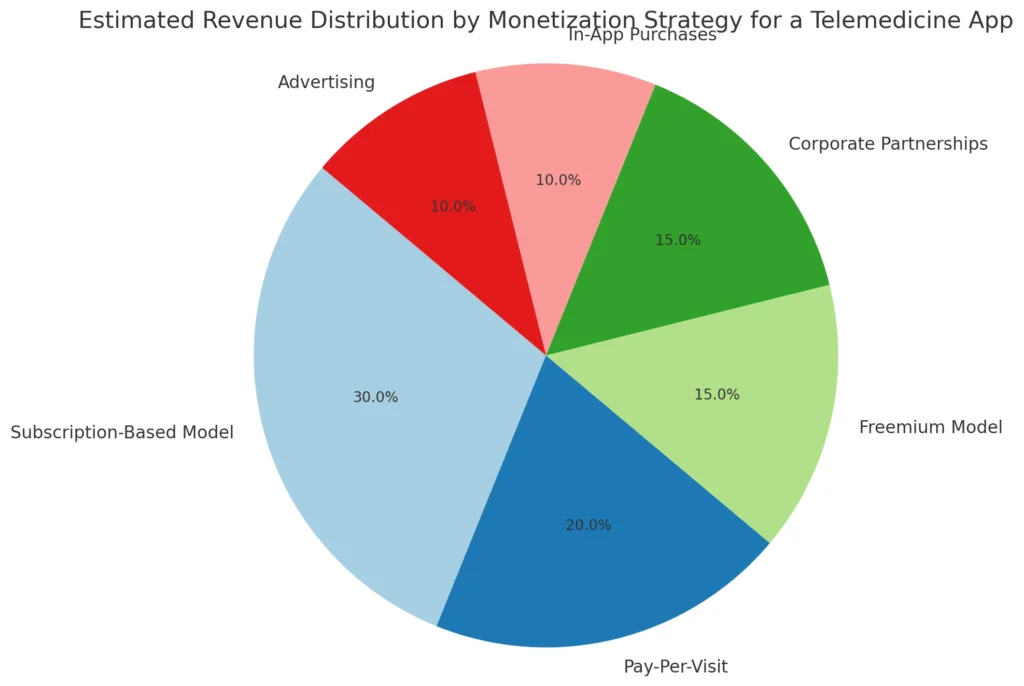
Creating a successful telemedicine app like MDLive isn’t just about providing excellent healthcare services; it’s also about establishing sustainable revenue streams. Here are some effective monetization strategies to consider:
- Subscription-Based Model: One of the most popular approaches in the telemedicine space is a subscription-based model. Patients can pay a monthly or annual fee for access to various services, such as unlimited consultations or premium features. This model ensures a steady income stream and encourages user retention.
- Pay-Per-Visit Consultations: Offering patients the option to pay for each consultation can attract users who may not want to commit to a subscription. This flexible pricing model allows patients to use the app as needed without long-term commitments, making it appealing to new users.
- Freemium Model: This model provides basic services for free while charging for premium features. For instance, users could access limited consultations for free but pay for specialized services, such as mental health support or access to specialists.
- Corporate Partnerships: Partnering with companies to offer your telemedicine services as part of their employee healthcare benefits can be lucrative. Businesses are increasingly looking to provide their employees with convenient healthcare options, and your app can be a valuable addition to their offerings.
- In-App Purchases: Consider incorporating in-app purchases for additional services, such as wellness programs, nutrition advice, or fitness coaching. These add-ons not only provide value to users but also create additional revenue opportunities.
- Advertising: If your app gains a significant user base, consider integrating relevant advertisements or partnerships with healthcare brands. However, it’s crucial to ensure that ads do not compromise the user experience or trust in your healthcare services.
By diversifying your revenue streams, you can create a sustainable business model that supports the ongoing development and improvement of your telemedicine app, ensuring it remains a vital resource for users seeking healthcare solutions.
Launching and Marketing the App
Successfully launching your telemedicine app like MDLive requires not just a well-built product but also effective marketing strategies to attract and retain users. Here’s a step-by-step guide to ensure your app makes a significant impact in the market:
- Pre-Launch Activities: Before your official launch, create buzz around your app. Utilize social media platforms to share teasers and sneak peeks of your app’s features. Engage with potential users through polls or surveys to gather insights and generate excitement.
- Build a Landing Page: Develop a dedicated landing page that outlines your app’s benefits, features, and unique selling points. Include a sign-up form for interested users to receive updates, which helps build an initial user base before the launch.
- Leverage Influencer Marketing: Partnering with healthcare influencers or industry experts can give your app credibility and reach a wider audience. Influencers can share their experiences using the app, which can drive engagement and downloads.
- App Store Optimization (ASO): Optimize your app’s listing on app stores with relevant keywords, engaging descriptions, and eye-catching visuals. Good ASO practices will improve your app’s visibility in search results, making it easier for users to find your app.
- Content Marketing: Create informative content related to telemedicine and healthcare, such as blog posts, articles, or videos. This content can position your app as a thought leader in the telemedicine space while driving organic traffic to your website and app.
- Launch Promotions: Consider offering special promotions during the launch period, such as discounted subscriptions or free trials. This can incentivize users to download and try your app, boosting initial user acquisition.
- Engage with Users Post-Launch: Once your app is live, continue engaging with your users. Collect feedback through in-app surveys or reviews and use this data to make improvements. Maintaining an active presence on social media and responding to user inquiries will build a loyal community around your app.
By implementing these marketing strategies, you can ensure a successful launch for your telemedicine app, paving the way for long-term growth and user satisfaction.
Read More “Teladoc’s Monetization Model: How It Dominates the Telemedicine Market“
Legal and Regulatory Considerations
| Consideration | Description |
|---|---|
| Data Privacy Laws | Comply with regulations like HIPAA to protect sensitive patient information. |
| Telemedicine Regulations | Understand state and country-specific laws regarding telemedicine practices and licensing. |
| Informed Consent | Implement mechanisms for obtaining user consent before consultations, outlining service details. |
| Terms of Service and Privacy Policy | Develop comprehensive documents to clarify user rights, data usage, and protection measures. |
| Malpractice and Liability Insurance | Encourage healthcare providers to secure insurance to mitigate legal risks associated with services. |
| Continuous Compliance | Regularly update practices to align with evolving healthcare laws and regulations. |
Navigating the legal landscape is crucial when developing a telemedicine app like MDLive. Given the sensitive nature of healthcare data, compliance with regulations is paramount to ensure patient safety and trust. Here are some key legal and regulatory considerations to keep in mind:
- Data Privacy Laws: Healthcare apps must comply with strict data privacy regulations, such as the Health Insurance Portability and Accountability Act (HIPAA) in the United States. HIPAA establishes standards for protecting sensitive patient information. Ensure that your app has robust encryption protocols, secure storage solutions, and strict access controls to safeguard user data.
- Telemedicine Regulations: Different states and countries have varying laws governing telemedicine practices. Familiarize yourself with these regulations, including licensing requirements for healthcare providers and the types of services that can be offered remotely. Compliance is essential to avoid legal pitfalls and ensure that practitioners can provide care legally through your platform.
- Informed Consent: Your app should include mechanisms for obtaining informed consent from users before consultations take place. This means clearly explaining the nature of the services provided, potential risks, and the privacy measures in place. Having a well-defined consent process protects both the users and your business.
- Terms of Service and Privacy Policy: Develop comprehensive terms of service and a privacy policy for your app. These documents should outline users’ rights and responsibilities, as well as how their data will be used, shared, and protected. Transparency builds trust with users and helps to mitigate legal risks.
- Malpractice and Liability Insurance: Encourage healthcare providers using your platform to obtain malpractice and liability insurance. While your app connects patients and providers, it’s important to have measures in place to address potential claims related to medical advice or treatment.
- Continuous Compliance: The legal landscape in healthcare is continually evolving, especially with the growth of telemedicine. Stay updated on regulatory changes and adapt your app accordingly. Regular audits and compliance checks can help ensure that your app remains in line with the latest laws and standards.
By prioritizing legal and regulatory compliance, you not only protect your users but also build a trustworthy platform that can thrive in the competitive telemedicine market.
Future Growth of the App
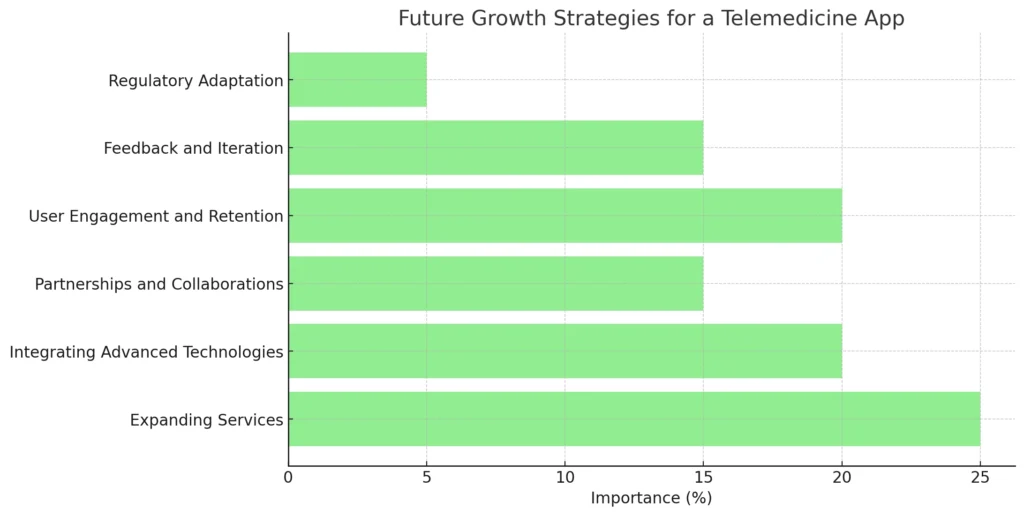
The telemedicine landscape is rapidly evolving, and building an app like MDLive not only addresses current healthcare needs but also positions your business for future growth. Here are key factors to consider for scaling and enhancing your telemedicine app over time:
- Expanding Services: As your app gains traction, consider broadening your range of services. Beyond general consultations, you could integrate specialized fields like dermatology, nutrition counseling, or mental health therapy. Offering diverse services can attract a wider user base and meet varied patient needs.
- Integrating Advanced Technologies: Keep an eye on emerging technologies like artificial intelligence (AI) and machine learning (ML). These technologies can enhance patient experience through personalized recommendations, chatbots for instant support, and predictive analytics to identify patient needs before they arise.
- Partnerships and Collaborations: Form strategic partnerships with healthcare providers, wellness programs, and insurance companies. Collaborations can enhance your app’s credibility and expand your reach, making it easier to offer integrated services that appeal to users.
- User Engagement and Retention: Focus on building a loyal user base through regular engagement. Implement features such as gamification, rewards for regular consultations, and community forums where users can share experiences. High engagement levels lead to better retention and user satisfaction.
- Feedback and Iteration: Continuously gather user feedback to understand pain points and areas for improvement. Conduct surveys, usability testing, and user interviews to refine features and introduce new ones that align with user expectations. This agile approach allows your app to adapt to changing market dynamics.
- Regulatory Adaptation: As telemedicine regulations evolve, be prepared to adapt your app accordingly. Staying compliant with new laws and guidelines will not only protect your business but also enhance user trust in your platform.
By planning for future growth, you can ensure that your telemedicine app remains relevant and continues to meet the changing needs of patients and healthcare providers. The potential for expansion in this thriving industry is immense, making it a prime time to invest in a telemedicine solution.
Keep an eye on emerging technologies like artificial intelligence, which can enhance patient experience through personalized recommendations and predictive analytics, as explored in this article on AI in healthcare.
Why Do You Trust Miracuves Solutions for Your Next Project?
Choosing the right partner for developing your telemedicine app is crucial to its success. Miracuves Solutions stands out as an exceptional choice for several compelling reasons:
- Cost-Effective Solutions: With a commitment to affordability, Miracuves Solutions offers ready-made app solutions at a fraction of the typical market cost—often around 10% of the global price. This allows startups and businesses to enter the telemedicine space without breaking the bank.
- Rapid Development Time: In the fast-paced healthcare industry, time is of the essence. Miracuves Solutions guarantees a turnaround time of just 10 days for ready-made apps, enabling you to launch quickly and capture market share before your competitors.
- Comprehensive Features: The apps developed by Miracuves Solutions come equipped with essential features tailored to meet the demands of modern telemedicine, including secure video consultations, appointment scheduling, and patient management systems. This ensures that your app is both functional and user-friendly from day one.
- Expertise and Support: The team at Miracuves Solutions consists of experienced developers and healthcare experts who understand the nuances of the telemedicine market. They provide ongoing support and insights, helping you navigate challenges and optimize your app post-launch.
- Customization Options: While Miracuves Solutions offers ready-made solutions, there’s also flexibility for customization. This allows businesses to tailor the app’s features and design to align with their brand and user needs, ensuring a unique offering in the marketplace.
- Focus on Compliance: With healthcare regulations constantly evolving, Miracuves Solutions prioritizes compliance with industry standards, such as HIPAA. This commitment to security and privacy helps build trust with your users and protects sensitive patient data.
By choosing Miracuves Solutions for your telemedicine app development, you’re not just getting a product; you’re securing a partner dedicated to your success in the competitive healthcare landscape. With cost-effective solutions, rapid development, and a focus on quality, Miracuves Solutions is equipped to bring your vision to life.
Conclusion
Building a telemedicine app like MDLive presents a tremendous opportunity in today’s digital healthcare landscape. With the growing demand for accessible and convenient healthcare solutions, your app can make a significant impact on patient care and engagement.
By leveraging Miracuves Solutions, you can bring your vision to life without the burden of high costs or lengthy development times. With a commitment to providing ready-made solutions that are both affordable and efficient, Miracuves Solutions empowers businesses to enter the telemedicine market quickly and confidently.
From understanding the essential features and technical requirements to navigating the legal landscape and planning for future growth, every step in the development process is crucial. By focusing on user-centric design and implementing effective monetization strategies, your app can not only meet the needs of today’s patients but also adapt to the evolving healthcare environment.
In a world where healthcare is increasingly moving online, investing in a telemedicine app is not just a smart business decision—it’s a way to contribute to the well-being of individuals and communities. With Miracuves Solutions as your partner, you’re well-equipped to tackle the challenges and seize the opportunities that lie ahead in the telemedicine space.
Transform healthcare with a custom telemedicine solution!
Whether it’s on-demand doctor visits, mental health support, or prescription management, we help you build a scalable and patient-friendly virtual care platform.
FAQs
How much does it cost to build a telemedicine app with Miracuves Solutions?
Building a telemedicine app with Miracuves Solutions can cost around $600, significantly lower than the typical market rate of $6,000.
How quickly can I launch my app with ready-made solutions?
You can expect your telemedicine app to be ready in just 10 days with Miracuves Solutions, allowing for a rapid market entry.
What are the core features included in a healthcare app like MDLive?
Essential features include virtual consultations, appointment scheduling, electronic prescriptions, patient health records, and secure payment integration.
Is my data safe with a telemedicine app?
Yes, Miracuves Solutions prioritizes data security and compliance with regulations like HIPAA to ensure your data is protected.
Can I customize my telemedicine app?
Absolutely! While Miracuves Solutions offers ready-made solutions, there are options for customization to align the app with your brand and user needs.
Discover smart healthcare innovations by Miracuves – designed for convenience, care, and digital health experiences:
Netmeds Like App – A modern pharmacy delivery application enabling users to order medicines online with ease and get doorstep delivery.
Practo Like App – A comprehensive platform for booking doctor appointments, managing medical records, and accessing virtual consultations.
Customizable PharmEasy Like App – A versatile healthcare application offering lab test bookings, medicine orders, and health products all in one place.
Lybrate Like App – A digital consultation tool that connects users with certified doctors for quick health advice, prescriptions, and follow-ups.



